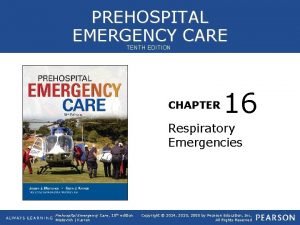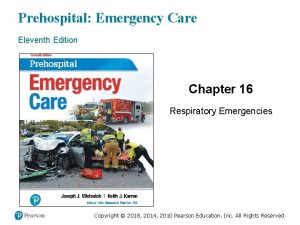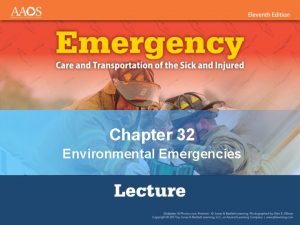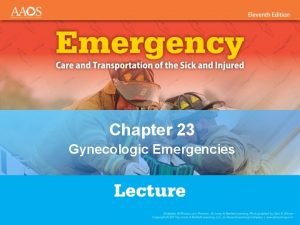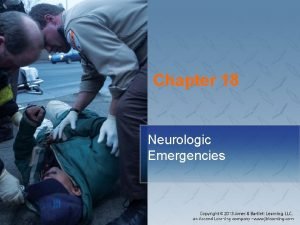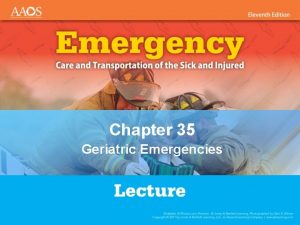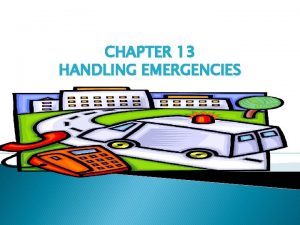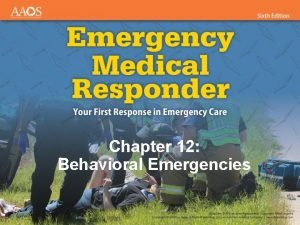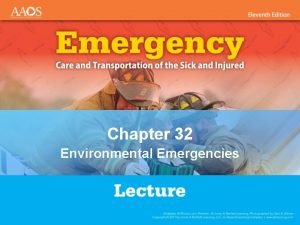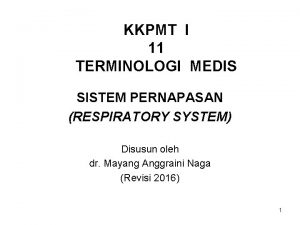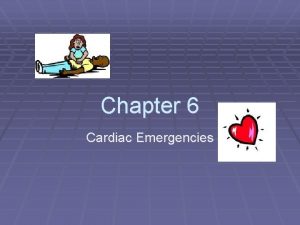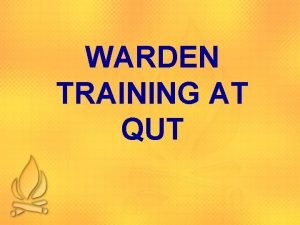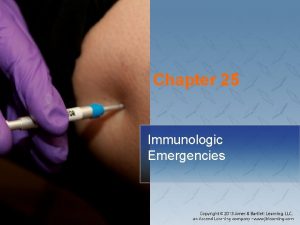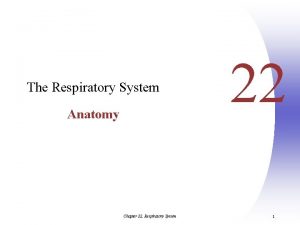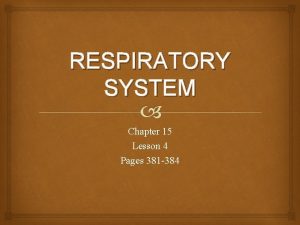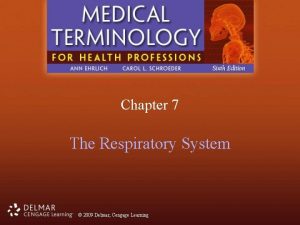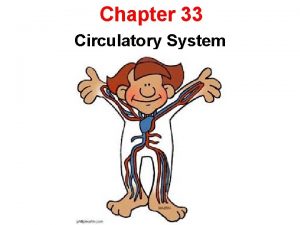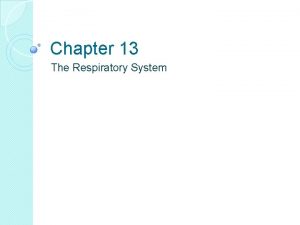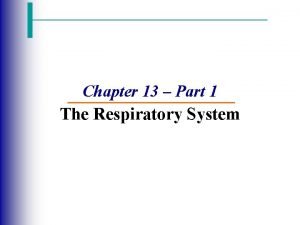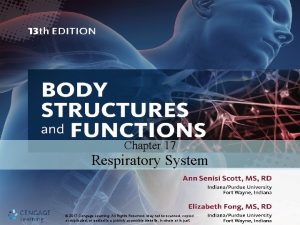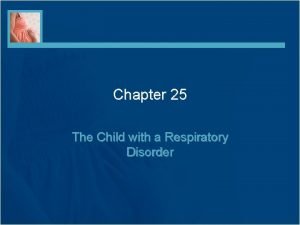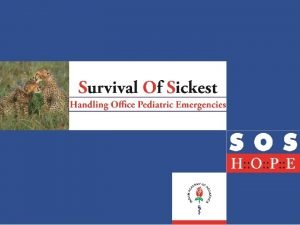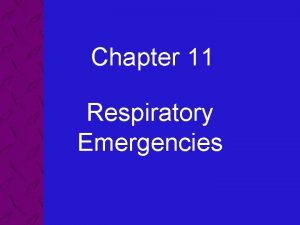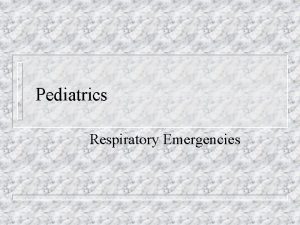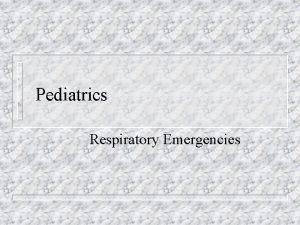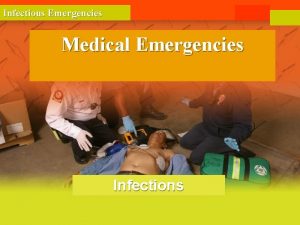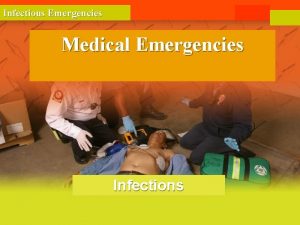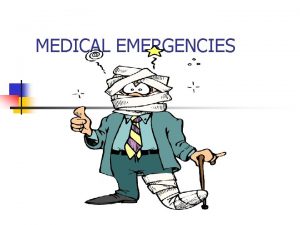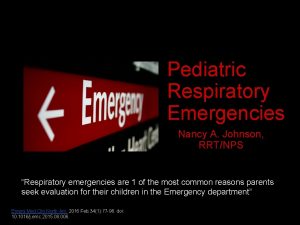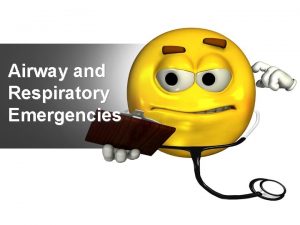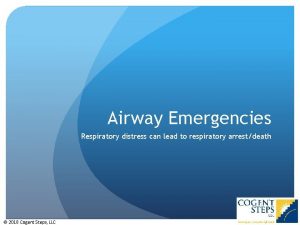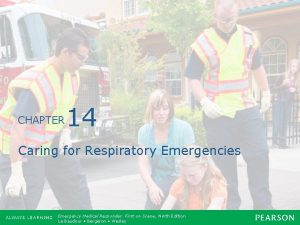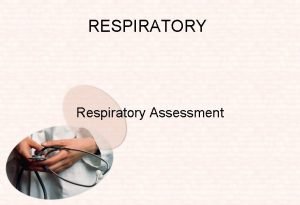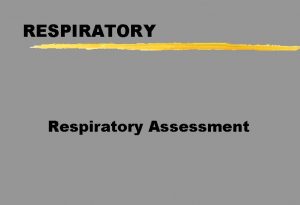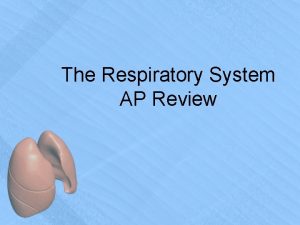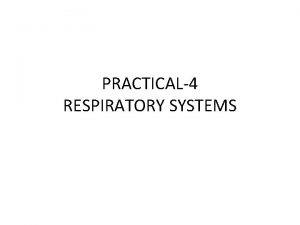Section 4 Medical Emergencies Chapter 10 Respiratory Emergencies








































- Slides: 40

Section 4: Medical Emergencies

Chapter 10 Respiratory Emergencies

Chapter 10: Respiratory Emergencies Objectives (1 of 2) • List the structure and function of the respiratory system. • State the signs and symptoms of a patient with difficulty breathing. • Describe the emergency medical care of the patient with breathing difficulty. 3

Chapter 10: Respiratory Emergencies Objectives (2 of 2) • Distinguish between the emergency medical care of the infant, child, and adult patient with breathing difficulty. • Describe the special considerations due to high altitude. • Defend OEC treatment regimens for various respiratory emergencies. • Demonstrate the emergency medical care for breathing difficulty. 4

Chapter 10: Respiratory Emergencies Respiratory System 5

Chapter 10: Respiratory Emergencies Anatomy and Function of the Lung 6

Chapter 10: Respiratory Emergencies Characteristics of Poor Breathing • Pulmonary vessels become obstructed. • Alveoli are damaged. • Air passages are obstructed. • Blood flow to the lungs is obstructed. • Pleural space is filled. 7

Chapter 10: Respiratory Emergencies Characteristics of Normal Breathing • Normal rate and depth • Regular breathing pattern • Good breath sounds on both sides of the chest • Equal rise and fall of chest • Movement of the abdomen 8

Chapter 10: Respiratory Emergencies Signs of Abnormal Breathing • Slower than 8 breaths/min or faster than 24 breaths/min • Muscle retractions • Pale or cyanotic skin • Cool, damp (clammy) skin • Shallow or irregular respirations • Pursed lips • Nasal flaring 9

Chapter 10: Respiratory Emergencies Dyspnea • Shortness of breath or difficulty breathing • Patient may not be alert enough to complain of shortness of breath. 10

Chapter 10: Respiratory Emergencies Upper or Lower Airway Infection • Infectious diseases may affect all parts of the airway. • The problem is some form of obstruction to the air flow or the exchange of gases. 11

Chapter 10: Respiratory Emergencies Acute Pulmonary Edema • Fluid build-up in the lungs • Signs and symptoms – Dyspnea – Frothy pink sputum • History of chronic congestive heart failure • Recurrence high 12

Chapter 10: Respiratory Emergencies Chronic Obstructive Pulmonary Disease (COPD) • COPD is the result of direct lung and airway damage from repeated infections or inhalation of toxic agents. • Bronchitis and emphysema are two common types of COPD. • Abnormal breath sounds may be present. – Rhonchi and wheezes 13

Chapter 10: Respiratory Emergencies Spontaneous Pneumothorax • Accumulation of air in the pleural space • Caused by trauma or some medical conditions • Dyspnea and sharp chest pain on one side • Absent or decreased breath sounds on one side 14

Chapter 10: Respiratory Emergencies Asthma or Allergic Reactions • Asthma is an acute spasm of the bronchioles. • Wheezing may be audible without a stethoscope. • An allergen can trigger an asthma attack. • Asthma and anaphylactic reactions can be similar. 15

Chapter 10: Respiratory Emergencies Pleural Effusion • • Collection of fluid outside lung Causes dyspnea Caused by irritation, infection, or cancer Decreased breath sounds over region of the chest where fluid has moved the lung away from the chest wall • Eased if patient is sitting up 16

Chapter 10: Respiratory Emergencies Mechanical Obstruction of the Airway • Be prepared to treat quickly. • Obstruction may result from the position of the head, the tongue, aspiration of vomitus, or a foreign body. • Opening the airway with the head tiltchin lift maneuver may solve the problem. 17

Chapter 10: Respiratory Emergencies Pulmonary Embolism • A blood clot that breaks off and circulates through the venous system • Signs and symptoms • Dyspnea • Acute pleuritic pain • Hemoptysis • Cyanosis • Tachypnea • Varying degrees of hypoxia 18

Chapter 10: Respiratory Emergencies Hyperventilation • Overbreathing resulting in a decrease in the level of carbon dioxide • Signs and symptoms – Anxiety – Numbness – A sense of dyspnea despite rapid breathing – Dizziness – Tingling in hands and feet 19

Chapter 10: Respiratory Emergencies Treatment of Dyspnea • Perform initial assessment. • Place the patient on oxygen. • If patient is in respiratory distress, ventilate. • Check pulse. 20

Chapter 10: Respiratory Emergencies Signs and Symptoms (1 of 2) • • Difficulty breathing Anxiety or restlessness Decreased respirations Cyanosis Abnormal breath sounds Difficulty speaking Accessory muscles 21

Chapter 10: Respiratory Emergencies Signs and Symptoms (2 of 2) • • Altered mental status Coughing Irregular breathing rhythm Tripod position Barrel chest Pale conjunctivae Increased pulse and respirations 22

Chapter 10: Respiratory Emergencies Emergency Medical Care • Give supplemental oxygen at 10 to 15 L/min via nonrebreathing mask. • Patients with longstanding COPD may be started on low-flow oxygen (2 L/min). • Assist with inhaler if available. • Consult medical control. 23

Chapter 10: Respiratory Emergencies Inhaler Medications • Trade names – Proventil – Ventolin – Alupent – Metaprel – Brethine • Generic names – Albuterol – Metaproterenol – Terbutaline 24

Chapter 10: Respiratory Emergencies Prescribed Inhalers • Actions – Relax the muscles surrounding the bronchioles – Enlarge the airways leading to easier passage of air • Side effects – Increased pulse rate – Nervousness – Muscle tremors 25

Chapter 10: Respiratory Emergencies Prior to Administration • Read label carefully. • Verify it has been prescribed by a physician for this patient. • Consult medical control. • Make sure the medication is indicated. • Check for contraindications. 26

Chapter 10: Respiratory Emergencies Contraindications for MDI • Patient unable to help coordinate inhalation • Inhaler not prescribed for patient • No permission from medical control • Maximum dose prescribed has been taken 27

Chapter 10: Respiratory Emergencies Administration of MDI (1 of 3) • Obtain order from medical control or local protocol. • Check for right medication, right patient, right route. • Make sure the patient is alert. • Check the expiration date. • Check how many doses have been taken. 28

Chapter 10: Respiratory Emergencies Administration of MDI (2 of 3) • Make sure inhaler is at room temperature or warmer. • Shake inhaler. • Stop administration of oxygen. • Ask the patient to exhale deeply and put lips around opening. • If the inhaler has a spacer, use it. 29

Chapter 10: Respiratory Emergencies Administration of MDI (3 of 3) • Have the patient depress the inhaler and inhale deeply. • Instruct the patient to hold his or her breath. • Continue administration of oxygen. • Allow the patient to breathe a few times, then repeat dose according to protocol. 30

Chapter 10: Respiratory Emergencies Reassessment • Carefully watch for shortness of breath. • 5 minutes after administration: – Obtain vital signs again. – Perform focused reassessment. • Transport and continue to assess breathing. 31

Chapter 10: Respiratory Emergencies Upper or Lower Airway Infection • Administer warm, humidified oxygen. • Do not attempt to suction the airway or insert an oropharyngeal airway in a patient with suspected epiglottitis. • Transport patient in position of comfort. 32

Chapter 10: Respiratory Emergencies Acute Pulmonary Edema • Administer 100% oxygen. • Suction secretions. • Transport in position of comfort. 33

Chapter 10: Respiratory Emergencies Chronic Obstructive Pulmonary Disease (COPD) • Assist with prescribed inhaler if patient has one. • Transport promptly in position of comfort. 34

Chapter 10: Respiratory Emergencies Spontaneous Pneumothorax • Administer oxygen. • Transport in position of comfort. • Monitor closely. 35

Chapter 10: Respiratory Emergencies Asthma or Allergic Reactions • Obtain history. • Assess vitals signs. • Assist with inhaler if patient has one. • Administer oxygen. • Transport promptly. 36

Chapter 10: Respiratory Emergencies Pleural Effusion • Definitive treatment is performed in a hospital. • Administer oxygen and support measures. • Transport promptly. 37

Chapter 10: Respiratory Emergencies Mechanical Obstruction of the Airway • Clear airway. • Administer oxygen. • Transport promptly. 38

Chapter 10: Respiratory Emergencies Pulmonary Embolism • Administer oxygen. • Place patient in comfortable position, usually sitting. • Assist breathing as necessary. • Keep airway clear. • Transport promptly. 39

Chapter 10: Respiratory Emergencies Hyperventilation • Complete initial assessment and history of the event. • Assume underlying problems. • Do not have patient breathe into a paper bag. • Give oxygen. • Reassure patient and transport. 40
 Chapter 16 respiratory emergencies
Chapter 16 respiratory emergencies Chapter 16 respiratory emergencies
Chapter 16 respiratory emergencies Conducting zone of the respiratory system
Conducting zone of the respiratory system Chapter 34 section 1 the circulatory system
Chapter 34 section 1 the circulatory system Chapter 32 environmental emergencies
Chapter 32 environmental emergencies Chapter 23 gynecologic emergencies
Chapter 23 gynecologic emergencies A behavioral crisis is most accurately defined as
A behavioral crisis is most accurately defined as Endocrine and hematologic emergencies
Endocrine and hematologic emergencies Chapter 18 neurologic emergencies
Chapter 18 neurologic emergencies Emt chapter 18 gastrointestinal and urologic emergencies
Emt chapter 18 gastrointestinal and urologic emergencies Chapter 28 lesson 1
Chapter 28 lesson 1 Gems diamond geriatric assessment
Gems diamond geriatric assessment Chapter 13 handling emergencies
Chapter 13 handling emergencies Chapter 12 behavioral emergencies
Chapter 12 behavioral emergencies Chapter 32 environmental emergencies
Chapter 32 environmental emergencies Chapter 16 cardiovascular emergencies
Chapter 16 cardiovascular emergencies Chapter 17 neurologic emergencies
Chapter 17 neurologic emergencies Kumpulan root terminologi medis
Kumpulan root terminologi medis Section quick check chapter 10 section 1 meiosis answer key
Section quick check chapter 10 section 1 meiosis answer key Quiz
Quiz Major nutritional deficiency diseases in emergencies
Major nutritional deficiency diseases in emergencies Lesson 6: cardiac emergencies and using an aed
Lesson 6: cardiac emergencies and using an aed Dic labs
Dic labs Psychiatric emergency
Psychiatric emergency Qut security contact number for emergencies
Qut security contact number for emergencies Immunologic emergencies
Immunologic emergencies California medical license for foreign medical graduates
California medical license for foreign medical graduates Gbmc medical records
Gbmc medical records Difference between medical report and medical certificate
Difference between medical report and medical certificate Torrance memorial tcu
Torrance memorial tcu Cartersville medical center medical records
Cartersville medical center medical records Chapter 7:10 respitory system
Chapter 7:10 respitory system Respiratory tree divisions
Respiratory tree divisions Chapter 22 respiratory system
Chapter 22 respiratory system Chapter 15 lesson 2 the respiratory system
Chapter 15 lesson 2 the respiratory system Chapter 7 the respiratory system labeling exercises
Chapter 7 the respiratory system labeling exercises Chapter 33 circulatory and respiratory systems
Chapter 33 circulatory and respiratory systems Chapter 13 the respiratory system
Chapter 13 the respiratory system Figure 13-1 respiratory system
Figure 13-1 respiratory system Chapter 17 respiratory system workbook answers
Chapter 17 respiratory system workbook answers The child with a respiratory disorder chapter 25
The child with a respiratory disorder chapter 25
